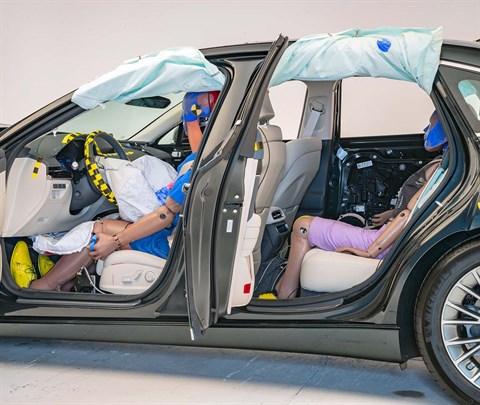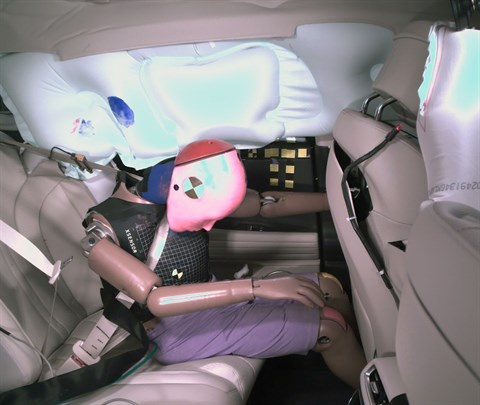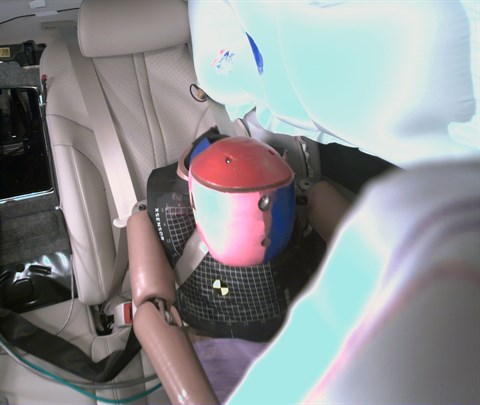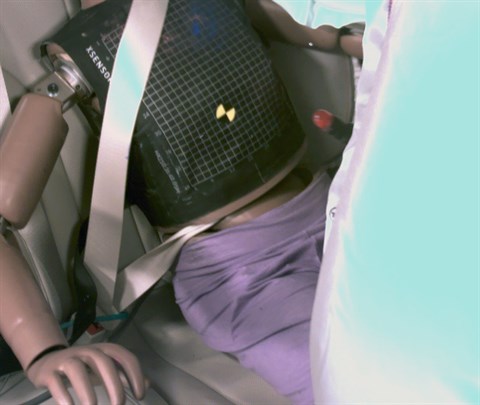Small overlap front
The small overlap front evaluation consists of a driver-side and a passenger-side component. If the results of the two evaluations differ, then the combined small overlap rating is equal to the lower rating.
Driver-side
- Rating applies to 2021-25 models
Tested vehicle: 2021 Genesis G80 3.5T
The Genesis G80 was redesigned for the 2021 model year. Driver-side small overlap frontal ratings are assigned by the Institute based on a test of a 2021 G80 conducted by Hyundai.
| Evaluation criteria | Rating |
|---|---|
| Overall driver-side evaluation | |
| Structure and safety cage | |
| Driver injury measures | |
| Head/neck | |
| Chest | |
| Hip/thigh | |
| Lower leg/foot | |
| Driver restraints and dummy kinematics | |
Passenger-side
- Rating applies to 2021-25 models
Tested vehicle: 2021 Genesis G80 3.5T
The Genesis G80 was redesigned for the 2021 model year. Passenger-side small overlap frontal ratings are assigned by the Institute based on a test of a 2021 G80 conducted by Hyundai.
| Evaluation criteria | Rating |
|---|---|
| Overall passenger-side evaluation | |
| Structure and safety cage | |
| Passenger injury measures | |
| Head/neck | |
| Chest | |
| Hip/thigh | |
| Lower leg/foot | |
| Passenger restraints and dummy kinematics | |
| Driver injury measures | |
| Head/neck | |
| Chest | |
| Hip/thigh | |
| Lower leg/foot | |
| Driver restraints and dummy kinematics | |
Moderate overlap front: original test
Rating applies to 2021-25 models
Tested vehicle: 2021 Genesis G80 3.5T
The Genesis G80 was redesigned for the 2021 model year. Moderate overlap frontal ratings are assigned by the Institute based on a test of a 2021 G80 conducted by Hyundai.
| Evaluation criteria | Rating |
|---|---|
| Overall evaluation | |
| Structure and safety cage | |
| Driver injury measures | |
| Head/neck | |
| Chest | |
| Leg/foot, left | |
| Leg/foot, right | |
| Driver restraints and dummy kinematics | |
Moderate overlap front: updated test
Rating applies to 2024-25 models built after October 2023 and before November 2024
Tested vehicle: 2024 Genesis G80 2.5T 4-door 4wd
The Genesis G80 was redesigned for the 2021 model year. Beginning with 2024 models built after October 2023, modifications were made to the rear seat belts to improve rear occupant protection in moderate overlap frontal crashes. (Information about when a specific vehicle was manufactured is on the certification label typically affixed to the driver door or adjacent B-pillar.)
| Evaluation criteria | Rating |
|---|---|
| Overall evaluation | |
| Structure and safety cage | |
| Driver injury measures | |
| Head/neck | |
| Chest | |
| Thigh/hip | |
| Leg/foot | |
| Driver restraints and dummy kinematics | |
| Rear passenger injury measures | |
| Head/neck | |
| Chest | |
| Thigh | |
|
Rear passenger restraints and dummy kinematics
| |

View of the vehicle after the crash showing the airbags and damage to the occupant compartment.

The rear passenger dummy's head remained a safe distance from the front seatback.

Rear passenger dummy injury values indicate a low risk of injury to the head or neck and chest. During the crash, the shoulder belt remained in an ideal position on the dummy’s chest.

The rear passenger dummy's lap belt moved from the ideal position on the pelvis onto the abdomen, increasing the risk of abdominal injuries.
Side: updated test
Rating applies to 2024-25 models
Tested vehicle: 2024 Genesis G80 4-door
The Genesis G80 was redesigned for the 2021 model year. Beginning with 2024 models, modifications were made to the door structure, reinforcements were added to the B-pillar and door sill, and pre-tensioning retractors were added to the rear seatbelts. These changes were implemented to improve occupant protection in side impact crashes. Side 2.0 ratings are assigned by the Institute based on a test of a 2024 G80 conducted by Hyundai/Kia.
| Evaluation criteria | Rating |
|---|---|
| Overall evaluation | |
| Structure and safety cage | |
| Driver injury measures | |
| Head/neck | |
| Torso | |
| Pelvis | |
|
Driver head protection
The dummy's head moved downward past the side curtain airbag and contacted the window sill of the driver door, while the head was in proximity to the intruding barrier. Although the barrier did not hit the dummy's head in this test, this near miss indicates that only slightly different crash circumstances could produce a direct hit to a person's head. The head protection is inadequate. | |
| Rear passenger injury measures | |
| Head/neck | |
| Torso | |
| Pelvis | |
|
Rear passenger head protection
During the crash, the rear dummy had excessively high head acceleration during inflation of the side curtain airbag, resulting in a downgrade of the head protection rating. | |
Headlights
Trim level(s)
- All trims
| Evaluation criteria | Rating |
|---|---|
| Low-beam headlight type | LED projector |
| High-beam headlight type | LED projector |
| Curve-adaptive? | No |
| High-beam assist? | Yes |
|
Overall rating | |
| Distance at which headlights provide at least 5 lux illumination: | |
Low beams
On the straightaway, visibility was fair on the left side of the road and inadequate on the right side. On curves, visibility was good on both right curves, fair on the sharp left curve and inadequate on the gradual left curve.
The low beams never exceeded glare limits.
High beams
On the straightaway, visibility was good on both sides of the road. On curves, visibility was good on the gradual left and gradual right curves, fair on the sharp left curve and inadequate on the sharp right curve.
High-beam assist compensates for some limitations of this vehicle's low beams on the straightaway and on both left curves.
Front crash prevention: pedestrian
Child seat anchors
Rating applies to 2021-25 models
| Evaluation criteria | Rating |
|---|---|
| Overall evaluation | |
| Vehicle trim | |
| Seat type | leather |
This vehicle has 2 rear seating positions with complete child seat attachment (LATCH) hardware.
It has 1 additional seating position with a tether anchor only.
| Evaluation criteria | Rating |
|---|---|
| Overall evaluation | |
| Vehicle trim | |
| Seat type | leather |
| Rating icon | Rating |
|---|---|
| G | Good |
| A | Acceptable |
| M | Marginal |
| P | Poor |
| Seating positions that rely on borrowed lower anchors or have only a tether anchor available are not rated. | |
thether anchor symbol | Tether anchor |
lower anchor symbol | Lower anchors |
| Lower anchor(s) can be borrowed from adjacent positions(s) | |
| No hardware available |
Details by seating position
| Position | Rating |
|---|---|
| 1 | |
| Tether anchor | |
| easy-to-find location | |
| no other hardware could be confused for anchor | |
| Lower anchors | |
| too deep in seat | |
| not too much force needed to attach | |
| easy to maneuver around anchors | |
| 2 | |
| Tether anchor | |
| easy-to-find location | |
| no other hardware could be confused for anchor | |
| Lower anchors | |
| none available | |
| 3 | |
| Tether anchor | |
| easy-to-find location | |
| no other hardware could be confused for anchor | |
| Lower anchors | |
| too deep in seat | |
| not too much force needed to attach | |
| easy to maneuver around anchors |
